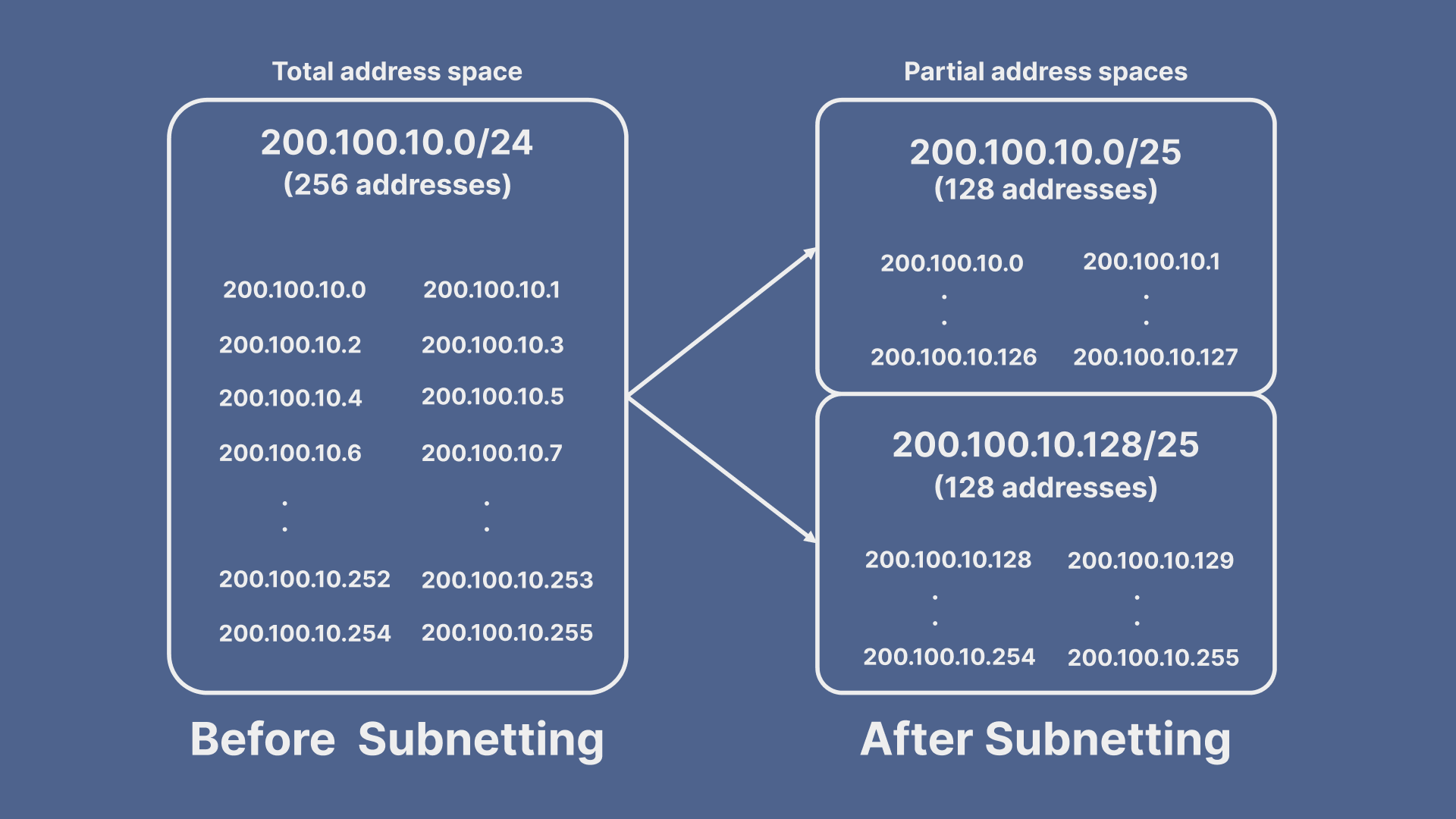Explainer – What Is a Subnet Mask?
10 February 2021What sets a subnet apart from a subnet mask? What is subnetting, and how can it benefit you? Find answers to these questions and more in this article.
- A subnet mask is a numerical label that distinguishes the network address from the host address within an IP address. A subnet is essentially a smaller segment within a larger network, requiring a subnet mask for accurate identification.
- Subnetting involves dividing a network into multiple subnets. Its primary purpose is to enhance the efficiency and security of data routing within a network. Additionally, subnetting optimizes the utilization of IPv4 addresses.
When a device connects to a network, it receives an IP address consisting of the network portion and the host portion. The network portion identifies the overall network, while the host portion specifies the individual device.
Without a subnet mask, the network and host addresses within an IP address are indistinguishable. The subnet mask enables network traffic to correctly interpret IP addresses by separating them into network and host portions.
For quick reference, use a subnet cheat sheet to determine the appropriate subnet mask for specific subnet and IP address pairings.
Network addresses before and after subnetting.
Is There a Difference Between Subnets and Subnet Masks?
No, subnets and subnet masks are distinct yet interconnected concepts. A subnet (short for subnetwork) refers to a specific segment of a network that shares the same IP address but has a unique subnet address. Conversely, a subnet mask delineates the parts of the IP address that pertain to the subnet from those that identify the host.
Understanding this distinction is essential for effective network configuration and management, ensuring efficient data routing and optimal network performance.
Why Use Subnetting?
Implementing subnets and subnet masks enhances security, streamlines network operations, and optimizes performance to meet business needs effectively. Here’s why:
Efficient Data Routing
Broadcast traffic often leads to inefficiencies in networks. Subnetting mitigates this by dividing broadcast domains, thereby reducing the number of nodes that broadcast traffic interacts with. This makes data routing more direct and efficient. For example, an ISP can create smaller networks for users in different regions, akin to breakout rooms in a Zoom call where conversations are more focused. Subnet masks ensure that traffic remains within its designated subnet, reducing congestion and load on the network. This results in faster data routing and improved overall network performance.
Enhanced Network Security
In large local networks with numerous connected devices, subnetting provides significant security benefits. If a subnet is compromised, only that segment is affected, limiting the attacker’s access. For instance, a company can segregate its internal network into subnets for HR, Finance, and Operations. If one subnet is breached, attackers only gain access to devices within that department, minimizing the overall impact. Network managers can control traffic flow through Route-maps, QoS, or ACLs, enabling them to identify and address threats more effectively. Subnets also isolate legitimate local traffic, preventing all devices from accessing the entire network and securing sensitive files or processes.
Prolonged IPv4 Lifespan
With the evolution of the internet, the limited number of IPv4 addresses has become a concern. Subnetting addresses this by increasing the utility of a single public IP address, allowing multiple private IP addresses within a single IP network. Each device on an IP network receives an IP address that includes the overall network IP address and its subnet. This significantly extends the viability of IPv4 as the internet standard, demonstrating how subnetting helps sustain the longevity of IPv4.
By incorporating these strategies, subnetting effectively enhances network performance, security, and efficiency, making it an essential practice for modern network management.
How Subnetting Works
Networks utilize Internet Protocol (IP) addresses to identify specific hardware, such as servers or computers. Subnetting, a fundamental network management technique, allows a single public IP address to be divided into multiple smaller networks, each with its own unique internal IP address.
In modern networks, which can connect hundreds or even thousands of devices, complex routing of traffic is required to reach the correct device’s IP address. Subnetting simplifies this process by creating sub-networks within a single physical network, thereby limiting IP address usage to a smaller set of devices. This optimization allows data to travel more directly to its destination without traversing the entire network.
To ensure accurate data packet delivery, logically organizing IP addresses is essential. This logical arrangement facilitates easy identification of network addresses and host addresses. For efficient subnetting and to ensure traffic reaches the correct destination, each IP address must be paired with a corresponding subnet mask.
By implementing subnetting, network administrators can enhance routing efficiency, reduce congestion, and improve overall network performance.
How Do IP Classes and Subnet Masks Relate?
Networks come in all sizes, from a handful of hosts to tens of thousands. To manage this diversity, IP addresses are categorized into classes: A, B, and C, with classes D and E reserved for specific uses like multicasting and research.
Even though most IP addresses today are classless, understanding these classes remains vital. The class of an IP address influences potential network size and how many octets are allocated to the subnet mask.
- Class A networks can support over 65,536 hosts. Here, the subnet mask designates the network address solely with the first octet, leaving the other three octets for host and subnet allocation.
- Class B networks have a subnet mask that covers the first two octets, allowing for connections from 256 to 65,534 hosts. The third and fourth octets are available for host assignment.
- Class C networks support fewer hosts, with the first three octets representing the network number. This leaves the final octet for up to 254 host addresses.
Both Class B and Class C addresses need a subnet mask to differentiate between network and host addresses.
Understanding this system is essential for effective network planning and administration, ensuring your network infrastructure is optimized for its intended purpose.
Understanding Network Addresses and Subnet Masks
For IPv4 addresses, each network class has a distinct default mask. Default subnet masks illustrate how many octets are allocated to the network address.
Examining the default subnet mask reveals the number and type of IP addresses within a network. Each subnet encompasses connected devices with a specific range of IP addresses.
Consider the IP address 10.45.21.0 paired with the subnet mask 255.255.255.0. This configuration indicates that the network address resides in 10.45.21, while the subnet for host addresses spans 10.45.21.0 to 10.45.21.255.
This precise allocation helps maintain organized and efficient network management, crucial for keeping up with the fast-paced tech environment. Stay informed and make data-driven decisions by understanding these foundational concepts in networking.
Common Subnetting Pitfalls
Navigating subnetting and subnet masks can be complex, often leading to these prevalent errors:
- Inaccurate calculation of subnet sizes: Miscalculations can result in subnets with insufficient or excessive IP addresses, affecting network scalability and efficiency. Improper sizing necessitates reconfigurations that could introduce additional complications.
- Overextended subnet ranges: Extensive subnets covering numerous devices enlarge the broadcast domain, increasing traffic and potentially overwhelming the network. This can lead to congestion and broadcast storms, critically impacting performance.
- Disorganized subnets: A lack of structured subnetting complicates network management, leading to difficulties in IP tracking, uneven resource allocation, and security issues. Implementing a structured approach with logical organization and thorough documentation is crucial. For instance, IPXO’s Next-Gen IPAM tool efficiently mitigates human error often seen with manual methods like Excel.
- Neglecting regular maintenance: Regularly reviewing and adjusting subnet configurations is vital to accommodate evolving network demands. Failure to do so results in outdated and inefficient subnet designs.
By addressing these common mistakes with a strategic and data-driven approach, organizations can optimize network performance and security.
Best Practices for Subnetting
Understanding subnetting and subnet masks is crucial in networking, especially with the ongoing transition to IPv6 adoption. Current best practices involve integrating IPv6 subnetting with IPv4 to manage a higher number of devices efficiently.
Moreover, emerging networking technologies such as Software-Defined Networking (SDN) and Network Function Virtualization (NFV) are transforming the design and application of subnets.
Subnet Masks: In Brief
Grasping subnet masks can be challenging without understanding IP addresses and why networks implement subnetting. Thus, defining a subnet mask isn’t entirely straightforward.
Now, with a foundational grasp of how IPv4 addresses facilitate data communication within and between networks, it’s clear why network administrators might opt for subnetting. Motivations include security, routing efficiency, network speed, and conserving public IPv4 addresses—often a combination of these factors.
Implementing subnetting necessitates using subnet masks to ensure inbound traffic routes correctly to host devices. Even in smaller systems, subnet masks are crucial for maintaining reliable and efficient network operations.
Advanced Subnetting Techniques
Moving beyond basic subnetting principles, advanced techniques can further optimize network performance and security. One such technique is Variable Length Subnet Masking (VLSM), which allows subnets of different sizes to be allocated according to the precise requirements of the network segments. This flexibility minimizes the waste of IP addresses and enhances efficient utilization of available address space.
Another technique is Subnetting with Classless Inter-Domain Routing (CIDR), which contributes to the reduction of routing table sizes and supports more efficient allocation of IP addresses. Unlike class-based addressing, CIDR does not restrict networks into rigid classes, allowing for more granular and adaptive address assignment.
Supernetting is a concept that combines multiple smaller networks into a larger address block, useful for simplifying routing. This approach typically applies in scenarios where multiple contiguous subnets can be aggregated to form a larger network, reducing the strain on routing resources.
For organizations managing large-scale networks, Hierarchical Subnetting introduces a multi-tiered subnet structure. This method breaks down larger networks into a hierarchy of smaller, manageable segments, easing administration, and improving fault isolation. Networks often employ hierarchical subnetting in conjunction with geographical or departmental subdivisions within an organization.
Lastly, Automated IP Address Management (IPAM) tools are essential when managing large subnet structures. These tools streamline the process of subnet allocation, address tracking, and policy enforcement, significantly reducing the risk of human error. IPXO’s Next-Gen IPAM tool exemplifies such systems, providing intuitive management and advanced analytics to support dynamic network environments.
By leveraging these advanced subnetting techniques, network administrators can construct robust, scalable, and efficient networks capable of meeting the complex demands of modern communication infrastructures.
Advanced Subnetting Techniques
Moving beyond basic subnetting principles, advanced techniques can further optimize network performance and security. One such technique is Variable Length Subnet Masking (VLSM), which allows subnets of different sizes to be allocated according to the precise requirements of the network segments. This flexibility minimizes the waste of IP addresses and enhances efficient utilization of available address space.
Another technique is Subnetting with Classless Inter-Domain Routing (CIDR), which contributes to the reduction of routing table sizes and supports more efficient allocation of IP addresses. Unlike class-based addressing, CIDR does not restrict networks into rigid classes, allowing for more granular and adaptive address assignment.
Supernetting is a concept that combines multiple smaller networks into a larger address block, useful for simplifying routing. This approach typically applies in scenarios where multiple contiguous subnets can be aggregated to form a larger network, reducing the strain on routing resources.
For organizations managing large-scale networks, Hierarchical Subnetting introduces a multi-tiered subnet structure. This method breaks down larger networks into a hierarchy of smaller, manageable segments, easing administration, and improving fault isolation. Networks often employ hierarchical subnetting in conjunction with geographical or departmental subdivisions within an organization.
Lastly, Automated IP Address Management (IPAM) tools are essential when managing large subnet structures. These tools streamline the process of subnet allocation, address tracking, and policy enforcement, significantly reducing the risk of human error. IPXO’s Next-Gen IPAM tool exemplifies such systems, providing intuitive management and advanced analytics to support dynamic network environments.
By leveraging these advanced subnetting techniques, network administrators can construct robust, scalable, and efficient networks capable of meeting the complex demands of modern communication infrastructures.
Subnet Mask FAQs
- What is a subnet mask? A subnet mask separates the network address from the host address within an IP address.
- How can you determine a subnet mask from an IP address? The subnet mask must be specified. It can be given in standard form (e.g., 255.255.255.0) or in CIDR notation (e.g., /24).
- What is the purpose of a subnet mask? The primary function of a subnet mask is to divide a network into smaller subnets, improving efficiency, security, and resource management.
- How is subnetting performed? To perform subnetting, determine the number of required subnets and hosts, select the appropriate subnet mask, and allocate IP addresses accordingly.
◼️


 2024
2024